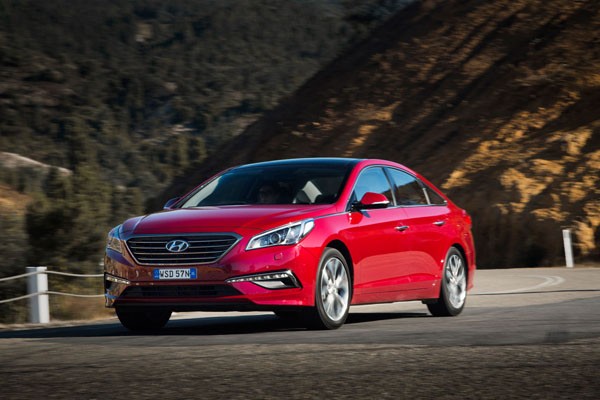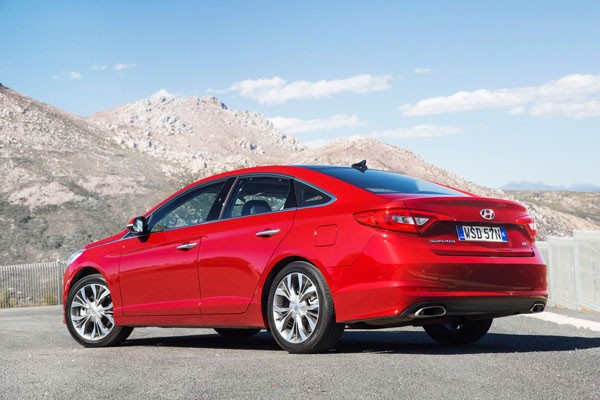Key changes to the Sonata have put the seventh generation of the Hyundai sedan in harmony with its classy upscale cousin, the Genesis. Not only that, the car also takes advantage of some first-rate Australian engineering input.
So what’s not to like about the car? Not much, really. Maybe the old-fashioned ignition key with no keyless entry and engine start; the awkward foot-operated parking brake in lieu of an electronic one, or lack of factory satellite navigation in the entry-level model.
The new Hyundai Sonata comes in three variants – Active, Elite and Premium. Active is powered by a 2.4-litre naturally aspirated four-cylinder engine, while Elite and Premium take advantage of a 2.0-litre turbocharged four. All make use of a six-speed automatic transmission.
Pricewise, the cars score well, with the Active 2.4 GDi opening the innings at $29,990, plus on-road costs. First wicket down is the Elite 2.0 Turbo GDi at $36,990, while tail-ender, the Premium 2.0 Turbo GDi, follows on at $41,990.
Hyundai owners benefit from lifetime capped price servicing, Australia’s first five-year unlimited kilometre warranty, a three-year MapCare Plan, complimentary roadside assist for 12 months on, plus 1500 km complimentary first service.
STYLING
As mentioned, the Sonata has taken styling cues from Hyundai’s luxury Genesis saloon, featuring Fluidic Sculpture 2.0, the second tranche of the South Korean manufacturer’s award-winning advanced design philosophy derived from nature.
The sedan has the appearance of European luxury with a pronounced grille and wider front air intake making way for smooth flanks and Sonata’s signature beltline. Its predecessor’s coupe-like roofline is continued but is now complemented by larger side windows. Seventeen-inch twin-spoke alloy wheels fill out their surrounds. The car carries a full-size spare.
A flat underbody enables the Sonata to come up with sports car-style aerodynamics in the form of a 0.27 co-efficient of friction, which successfully does its bit for fuel economy.
As with the shape, Hyundai has gone all philosophical with the interior, designed with three core Human Machine Interface principles in mind: safety, by minimising visual distraction; simplicity, by presenting concise and relevant information; and intuitiveness, through improved user interfaces.
Quality cloth upholstery, soft-touch materials on the dashboard top and door trims, as well as textured metallic-painted garnish panels complete the stylish interior decor.
With 25 mm more rear legroom over its predecessor, the new Sonata is up with its Australian-market competitors, such as Camry and Mazda6, in most dimensions.
Convenience abounds. A nifty touch is the mechanism for folding the rear seat backs to increase the 510 litres of luggage space. A couple of tabs attached to the boot roof can be pulled to release the seat back locks while standing behind the vehicle, that’s after unlocking the boot electronically with the key fob.
INFOTAINMENT
Hyundai Active comes with a touchscreen Multimedia System with 4.3-inch colour display and offers a wide range of connectivity, including USB, AUX, digital iPod, and Bluetooth, and six speakers, including two front tweeters.
A 3.5-inch OLED display among the dash instruments shows average fuel consumption, distance to empty, service intervals and a range of vehicle settings.
ENGINES
The 2.4-litre Theta-II Gasoline Direct injection (GDi) engine of the Active produces 138 kW of power at 6000 rpm and 241 Nm of torque at 4000rpm, the latter tuned for optimum low-end torque, resulting in improved driveability and take-off.
Powertrain engineers also trimmed the engine’s peak power to shift its band downwards for better low-rev responsiveness, while Hyundai’s own electronically controlled six-speed Shiftronic automatic transmission with lock-up torque converter and sequential manual shift mode has been added to the mix.
SAFETY
A rigid, energy absorbing body structure, plus plenty of active and passive safety measures, including vehicle stability management, have won the Sonata a five-star ANCAP safety rating.
The reversing camera projects a clear image on the multimedia/navigation screen in the centre stack, while rear parking sensors indicate any obstacles in the dash cluster display.
DRIVING
Rated as a medium-size car in Australia, ironically in the USA the new Sonata is officially classified by the Environmental Protection Agency as a large one, which puts a friendlier light on the fuel figures, a rated 8.3 litres per 100 kilometres on the combined urban / highway cycle. The test car wasn’t exactly economical, it ranged in the low to mid-teens litres per 100 kilometres tripping around town and 6.4 litres on a highway run.
The above results were gathered in the car’s Drive normal mode, which can be altered by flicking between Eco, Normal and Sport with a switch on the centre console. Through powertrain management, performance is altered accordingly.
Normal produces a comfortable, cruisy kind of going; Eco is the ‘guilt trip’ default mode aimed at cutting fuel consumption, hence nasty emissions; while Sport adds revs and noise to the engine, plus a little more get up and go.
I’m ambivalent about it all. Fuel consumption and emissions are greatly a matter of how the driver behaves with his or her foot on the gas pedal, anyway; and Sport, unless it can get the true car lover’s heart racing, is wasted. So, Hyundai, why bother?
A calm, largely noise-free cabin, is the result of increased use of sound deadening material in the dashboard, more sound absorption materials under the floorpan, and a new underbody tray, which helps reduce unwanted road row and aerodynamically helps on saving petrol.
SUMMING UP
Hyundai may regret having made such play on similarities between the Sonata and its superstar Genesis, for while it has some of the outward glamour of the would-be automotive A-lister, the new mid-size sedan is short on the technical brain power and clobber needed to cosset demanding owners. Well, what do we expect for half the price? It’s up to the market to focus on looks rather than the latter.
AT A GLANCE
MODEL LINE-UP
Hyundai Sonata Active 2.4 GDi petrol six-speed automatic: $29,990
Hyundai Sonata Elite 2.0 Turbo GDi petrol six-speed automatic: $36,990
Hyundai Sonata Premium 2.0 Turbo GDi petrol six-speed automatic: $41,990
Note: These prices do not include dealer or government charges. Contact your local Hyundai dealer for drive-away prices.
FEATURES
ABS anti-locking brakes
Electronic brake-force distribution
Brake assist
Vehicle stability management
Traction control
Hill start assist
Automatic dusk sensing headlamps
Emergency Stop Signal
LED Daytime Running Lamps
Rear view camera
Rear parking assist
17in alloy wheels with 215/55R17 tyres
Keyless entry with security alarm
4.3in touchscreen audio system with CD player, MP3 capability and six speakers
AUX / USB audio input with digital iPod compatibility
Bluetooth connectivity (hands free phone & audio streaming)
Steering wheel-mounted audio and phone controls
3.5in OLED display in dash cluster
Cruise control with steering wheel-mounted controls
Front and rear power windows
SPECIFICATIONS:
(2.4-litre four-cylinder petrol engine)
Capacity: 2359 cc
Configuration: Transverse front engine, front wheel drive, 16 valves, dual overhead cam with Dual Continuously Variable Valve Timing and mechanical lash adjusters
Bore and stroke: 88 mm x 97 mm
Compression ratio: 11.3:1
Maximum Power: 138 kW @ 6000 rpm
Maximum Torque: 241 Nm @ 4000 rpm
DRIVELINE:
Drivetrain: Front-wheel drive, 6-speed automatic, electronically controlled with lock-up torque converter
DIMENSIONS, WEIGHT AND CAPACITIES:
Length: 4855 mm
Width: 1865 mm
Height: 1475 mm
Wheelbase: 2805 mm
Track: 1602 mm (front); 1609 mm (rear)
Ground clearance: 135 mm
Kerb weight: 1500-1587 kg
Gross vehicle mass: 2060 kg
Towing capacity: 1300 kg (braked) / 750 kg (unbraked)
Seating capacity: 5
Cargo capacity: 510 litres
Fuel Tank Capacity: 70 litres
Turning circle: 10.9 m
SUSPENSION AND BRAKES:
Suspension: MacPherson strut with Amplitude Selective Dampers (front); Multi-link with Amplitude Selective Dampers (rear)
Brakes: Ventilated discs (front); solid discs (rear). Dual-diagonal, split circuit, power assisted with electronic brake-force distribution and brake assist
Steering: Motor Driven Power Steering, rack and pinion
Wheels / tyres: 17 x 7.0J alloy. 215/55 R17. Full-size spare
PERFORMANCE
Acceleration 0 to 100 km/h: N/A
Top speed: N/A
FUEL CONSUMPTION:
Fuel type: 91 RON unleaded
Combined Cycle (ADR 81/01): 8.3 litres per 100 km. CO2 emissions 194 g / km
GREEN VEHICLE GUIDE RATINGS:
Greenhouse Rating: 6.5 / 10
Air Pollution Rating: 7.5 / 10
WARRANTY:
5 years / unlimited kilometres











